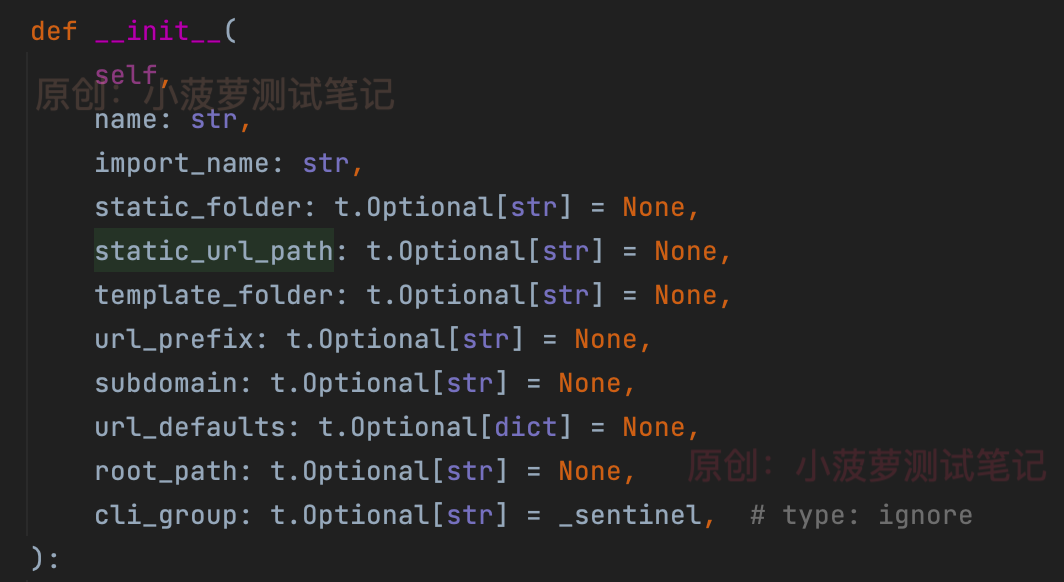Flask(9)- 蓝图的基本使用
前言
- 在前面的例子中,所有的页面处理逻辑都是放在同一个文件中,随着业务代码的增加,将所有代码都放在单个程序文件中是非常不合适的
- 不仅会让阅读代码变得困难,而且会给后期维护带来麻烦
- Flask 中使用蓝图,提供了模块化管理程序路由的功能,使程序结构更加清晰
蓝图简介
- 随着 Flask 程序越来越复杂,需要对程序进行模块化的处理
- 蓝图 (Blueprint) 是 Flask 程序的模块化处理机制
- 它是一个存储视图方法的集合
- Flask 程序通过 Blueprint 来组织 URL 以及处理请求
Blueprint 具有以下属性
- 一个项目可以具有多个 Blueprint
- Blueprint 可以单独拥有自己的模板、静态文件的目录
- 在应用初始化时,注册需要使用的 Blueprint
基本用法
功能概述
假设网站包含有如下 4 个页面:
| 页面 | 功能 | 处理函数 |
|---|---|---|
| /news/society/ | 社会新闻版块 | society_news |
| /news/tech/ | IT 新闻版块 | tech_news |
| /products/car/ | 汽车产品版块 | car_products |
| /products/baby/ | 婴幼儿产品版块 | baby_products |
- 前两个都是 /news 前缀,可以组成一个蓝图 news
- 后两个是 /products 前缀,可以组成一个蓝图 products
- 相当于四个视图函数,两个蓝图
程序中包含 4 个视图函数,根据页面路径,Flask 将请求转发给对应的视图函数,从浏览器发送过来的请求的处理过程如下图所示

使用蓝图后,路由匹配流程
- 浏览器访问路径 /products/car
- Flask 框架在蓝图 news 和蓝图 products 中查找匹配该页面路径的路由
- 发现在蓝图 products 中,存在和路径 /products/car 匹配的视图函数 car_products
- 最后将请求转发给函数 car_products 处理
实战小栗子
目录结构
例子程序包括 2 个蓝图,由 3 个文件构成:
app.py,程序的主文件;news.py,实现蓝图 news;products.py,实现蓝图 products。
app.py 代码
#!usr/bin/env python # -*- coding:utf-8 _*- """ # author: 小菠萝测试笔记 # blog: https://www.cnblogs.com/poloyy/ # time: 2021/7/12 8:36 下午 # file: app.py """ # 导入 Flask 和 蓝图 Blueprint from flask import Flask, Blueprint # 导入蓝图类 from s7_blueprints import news from s7_blueprints import products app = Flask(__name__) # 注册蓝图 app.register_blueprint(news.blueprint) app.register_blueprint(products.blueprint) if __name__ == '__main__': app.run(debug=True)
news.py 代码
#!usr/bin/env python # -*- coding:utf-8 _*- """ # author: 小菠萝测试笔记 # blog: https://www.cnblogs.com/poloyy/ # time: 2021/7/12 8:36 下午 # file: news.py """ # 导入蓝图 from flask import Blueprint """ 实例化蓝图对象 第一个参数:蓝图名称 第二个参数:导入蓝图的名称 第三个参数:蓝图前缀,该蓝图下的路由规则前缀都需要加上这个 """ blueprint = Blueprint('news', __name__, url_prefix="/news") # 用蓝图注册路由 @blueprint.route("/society/") def society_news(): return "社会新闻板块" @blueprint.route("/tech/") def tech_news(): return "新闻板块"
注意:页面的绝对路径是 /news/society/ 和 /news/tech/,因为蓝图的 url_prefix 设置为 news,在蓝图内部,页面的相对路径是 /society/ 和 /tech/
products.py 代码
#!usr/bin/env python # -*- coding:utf-8 _*- """ # author: 小菠萝测试笔记 # blog: https://www.cnblogs.com/poloyy/ # time: 2021/7/12 8:36 下午 # file: products.py """ from flask import Blueprint blueprint = Blueprint("products", __name__, url_prefix="/product") @blueprint.route("/car") def car_products(): return "汽车产品版块" @blueprint.route("/baby") def baby_products(): return "婴儿产品版块"
注意:页面的绝对路径是 /products/car/ 和 /product/baby/,因为蓝图的 url_prefix 等于 products,在蓝图内部,页面的相对路径是 /car/ 和 /baby/
postman 发起请求的结果


更具扩展性的架构
概述
随着业务代码的增加,需要为 Flask 程序提供一个具备扩展性的架构,根据 Flask 程序的扩展性分为如下三种类型:
1、所有的页面逻辑放在同一个文件中
在这种架构中,程序完全不具备扩展性
在初学 Flask 时,使用的栗子都是这种类型
2、使用一个独立的 Python 文件实现蓝图
在这种架构中,程序具备一定的扩展性:
- 程序由主程序和多个蓝图构成
- 每个蓝图对应一个 Python 文件
- 所有的蓝图共享相同的模板文件目录
- 所有的蓝图共享相同的静态文件目录
上面的栗子就是采用这种架构
程序包含 2 个蓝图: news 和 products,由 3 个文件构成:app.py、news.py、products.py,其中 news.py 实现新闻版块,products.py 实现产品版块
3、使用一个独立的目录实现蓝图
在这种架构中,程序的扩展性最好:
- 程序由主程序和多个蓝图构成
- 每个蓝图对应一个独立的目录,存储与这个蓝图相关的文件
- 每个蓝图有一个独立的模板文件目录
- 每个蓝图有一个独立的静态文件目录
模板文件寻找规则
每个蓝图可以拥有独立的模板文件目录,模板文件寻找规则如下:
- 如果项目中的 templates 文件夹中存在相应的模板文件,则使用 templates 文件夹下的模板文件;
- 如果项目中的 templates 文件夹中没有相应的模板文件,则使用定义蓝图的时候指定的 templates 文件夹下的模板文件
- 项目中的 templates 文件夹优先级大于指定的 templates 文件夹
静态文件寻找规则
每个蓝图可以独立的静态文件目录,静态文件寻找规则如下:
- 如果项目中的 static 文件夹中存在相应的静态文件,则使用 static 文件夹下的静态文件
- 如果项目中的 static 文件夹中没有相应的静态文件,则使用定义蓝图的时候指定的 static 文件夹下的静态文件
- 项目中的 templates 文件夹优先级大于指定的 templates 文件夹
究极扩展性的栗子
目录结构

目录功能描述
| 路径 | 功能描述 |
|---|---|
| templates | 项目默认的模板文件夹 |
| static | 项目默认的静态文件夹 |
| news | 蓝图 news 的相关文件 |
| news/templates | 蓝图 news 的私有模板文件夹 |
| news/static | 蓝图 news 的私有静态文件夹 |
| products | 蓝图 products 的相关文件 |
| products/templates | 蓝图 products 的私有模板文件夹 |
| products/static | 蓝图 products 的私有静态文件夹 |
文件功能描述
| 路径 | 功能描述 |
|---|---|
app.py |
主程序 |
| news/__init.py__ | 蓝图 news 的实现 |
| news/templates/society.html | 属于蓝图 news 的一个模板文件 |
| news/static/news.css | 属于蓝图 news 的一个静态文件 |
| products/__init.py__ | 蓝图 products 的实现 |
app.py 的代码
#!usr/bin/env python # -*- coding:utf-8 _*- """ # author: 小菠萝测试笔记 # blog: https://www.cnblogs.com/poloyy/ # time: 2021/7/12 10:39 下午 # file: 7_blueprint_app.py """ from flask import Flask from s7_news import news from s7_product import products app = Flask(__name__) app.register_blueprint(news.blueprint) app.register_blueprint(products.blueprint) app.run(debug=True)
news/__init.py__ 的代码
#!usr/bin/env python # -*- coding:utf-8 _*- """ # author: 小菠萝测试笔记 # blog: https://www.cnblogs.com/poloyy/ # time: 2021/7/12 8:36 下午 """ # 导入蓝图 from flask import Blueprint, render_template """ 实例化蓝图对象 第一个参数:蓝图名称 第二个参数:导入蓝图的名称 第三个参数:蓝图前缀,该蓝图下的路由规则前缀都需要加上这个 """ blueprint = Blueprint('news', __name__, url_prefix="/news", template_folder="templates", static_folder="static") # 用蓝图注册路由 @blueprint.route("/society/") def society_news(): return render_template('society.html') @blueprint.route("/tech/") def tech_news(): return "IT 新闻板块"
- 蓝图中页面的 URL 前缀为 /news;
- 蓝图的模板目录为 templates,绝对路径为 ‘项目目录 /news/templates’;
- 蓝图的静态文件目录为 static,绝对路径为 ‘项目目录 /news/static’
- 调用 render_template (‘society.html’) 渲染模板文件 society.html,根据模板文件的查找规则,最终在 ‘项目目录 /news/templates’ 目录下找到模板文件
news/templates/society.html 的代码
<link rel="stylesheet" href="{{ url_for('news.static',filename='news.css')}}"> <h1>社会新闻</h1>
在模板文件中引用了静态文件 news.css。{{url_for (‘news.static’,filename=‘news.css’) }} 的输出为 news/static/news.css,其中 news.static 表示蓝图 news 的 static 目录
news/static/news.css 的代码
h1 { color: red; }
product.py/__init.py__ 的代码
from flask import Blueprint blueprint = Blueprint('products', __name__, url_prefix='/products') @blueprint.route("/car") def car_products(): return "汽车产品版块" @blueprint.route("/baby") def baby_products(): return "婴儿产品版块"
浏览器访问效果
访问 http://localhost:5000/news/society/

验证目录优先级
在根目录下的 templates 目录下也添加一个 society.html 文件,在根目录下的 static 目录下添加一个 project.css
html 代码
<!DOCTYPE html> <html lang="en"> <head> <meta charset="UTF-8"> <title>Title</title> </head> <body> <link rel="stylesheet" href="{{ url_for('static',filename='project.css') }}"> <h1>社会新闻啊啊啊</h1> </body> </html>
css 代码
h1 {
color: blue;
}
预期结果
- 根据 templates、static 的查找规则,会优先查找项目根目录的 templates、static 目录下是否有对应的模板文件、静态文件
- 这里 society.html 同时出现在根目录的 templates 和蓝图目录的 templates,应该优先返回根目录的 templates 下的 society.html
浏览器访问效果

符合预期结果
Blueprint 源码解析
类初始化 __init__ 方法参数列表

- name:蓝图名称,将会被添加到每个 endpoint
- import_name:蓝图包的名称,通常是 __name__,有助于找到 root_path 蓝图
- static_folder:包含静态文件的文件夹,由蓝图的静态路由提供服务,路径以蓝图文件为根路径开始找
- static_url_path:提供静态文件的 url,默认就是 static_folder,如果蓝图没有 url_prefix,应用程序的静态路由将优先,并且蓝图的静态文件将无法访问
- template_folder:包含模板文件的文件夹,路径以蓝图文件为根路径开始找
- url_prefix:会作为蓝图所有路由的前缀路径
- subdomain:蓝图路由将匹配的子域
- url_defaults:蓝图路由的默认值字典
- root_path:默认情况下,蓝图会自动设置这基于“import_name”




【推荐】国内首个AI IDE,深度理解中文开发场景,立即下载体验Trae
【推荐】编程新体验,更懂你的AI,立即体验豆包MarsCode编程助手
【推荐】抖音旗下AI助手豆包,你的智能百科全书,全免费不限次数
【推荐】轻量又高性能的 SSH 工具 IShell:AI 加持,快人一步
· 从 HTTP 原因短语缺失研究 HTTP/2 和 HTTP/3 的设计差异
· AI与.NET技术实操系列:向量存储与相似性搜索在 .NET 中的实现
· 基于Microsoft.Extensions.AI核心库实现RAG应用
· Linux系列:如何用heaptrack跟踪.NET程序的非托管内存泄露
· 开发者必知的日志记录最佳实践
· winform 绘制太阳,地球,月球 运作规律
· 超详细:普通电脑也行Windows部署deepseek R1训练数据并当服务器共享给他人
· TypeScript + Deepseek 打造卜卦网站:技术与玄学的结合
· AI 智能体引爆开源社区「GitHub 热点速览」
· 写一个简单的SQL生成工具
2020-07-13 Jmeter系列(45)- 详解 Jmeter 跨线程组取参数值的方法,免代码!
2020-07-13 Jmeter系列(46)- Jmeter 中有哪些常用的函数